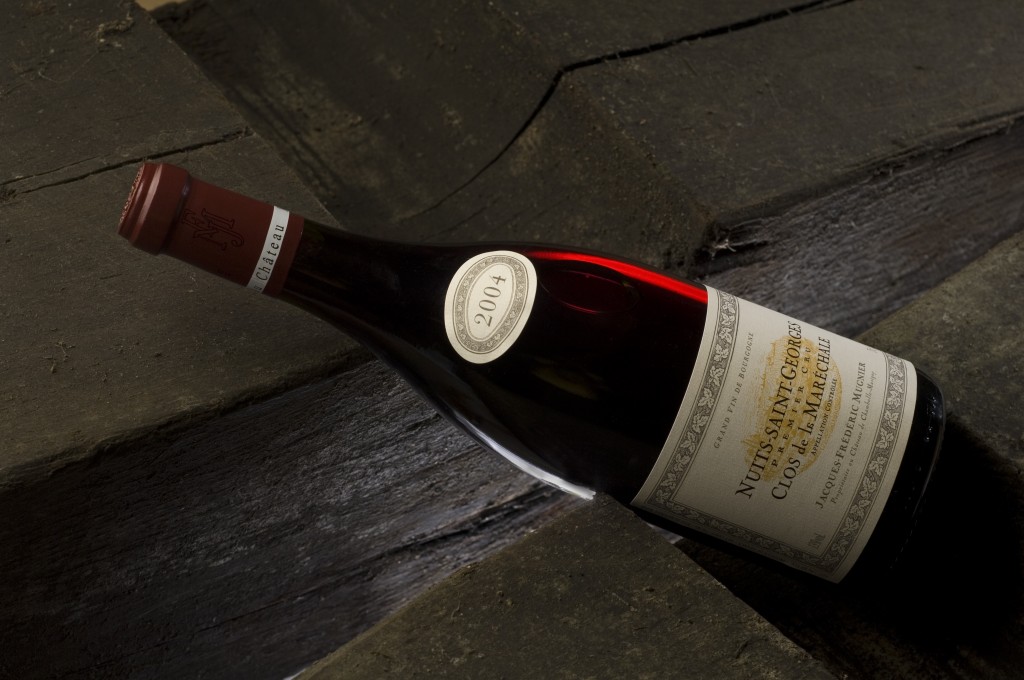Nuits-Saint-Georges, Clos de la Maréchale 2004-2015
Domaine Jacques-Frédéric Mugnier
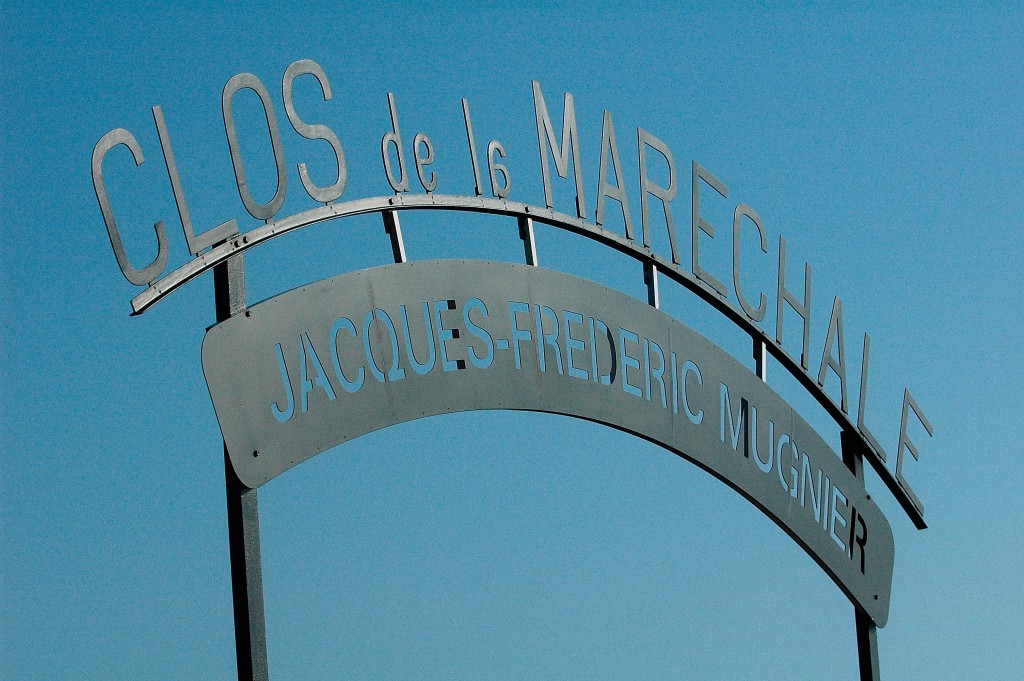
An introduction by Frédéric Mugnier:
“The vineyard was purchased in 1902 by my great, great, grandfather. I cannot find the origin of the name, but I found the name recored first in 1892. The first name of the vineyard was Clos des Fources. An historian found this name recorded in the 1840. The Clos was created in the 1820 and the wall and the house in the middle were built at this time. It appears in the first edition of the Napoleonic record, which was published in 1827. This maps the Clos de la Maréchale with the same shape and dimensions as it has today.”
“From 1902 it was farmed by my family and then from 1950-2003 it was farmed by Faiveley.”
“It is a large rectangle. You can see it from the road. I was a little sceptical of the quality of the vineyard before I started to make it, as it is rather flat and it is right next to the Route 74 which in Chambolle is not a great location. So I thought it would have deep, clay soil, but we have done research and surveys in the vineyard to characterise the soil and it is very shallow, just 50 cm of clay on a solid rock table. The layer of rock is different though – it is oolitic limestone, which is soft and porous, which is a good thing. It actually retains water in periods of drought. To me it is exactly the specificity of great terroir – the capacity to evacuate too much water, but to retain enough for the vines.”
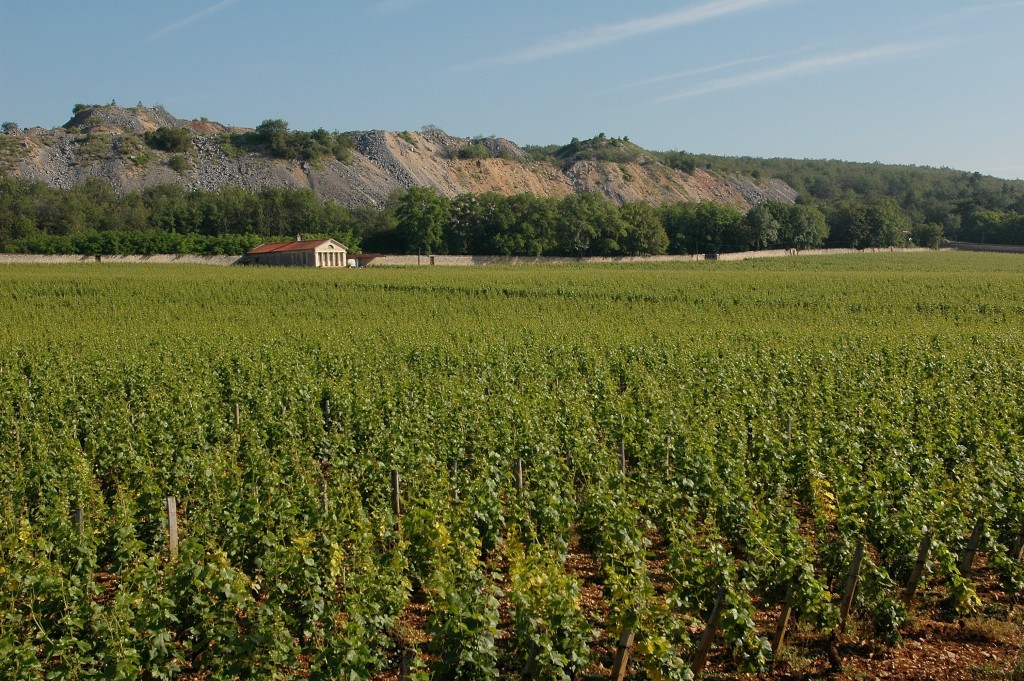
“There is a small section which has deep soil, clay, sand and rocks and was probably in the path of an ancient stream. This is more sensitive to excess water and to lack of water, but I have not seen a clear difference in the quality of the grapes. Weeds don’t grow as well in this section in drought. To be honest it is not consistent year after year, which are the best sections. It seems to me the soil is not the most important factor, rather it is the age of the vines. The best quality is the southern end where the oldest vines are, even though this is not the best soil.”
“The vineyard is divided into 8 blocks. There is a section planted in the 1890s. The other blocks were planted by Faiveley in a very systematic fashion. Every year they replanted one strip, starting in 1954 to continuing to 1986, so over 30 years. The youngest vines are now 30 years old. It was planted in a massale selection and then in clones from the 1980s. There was one section planted with a massale selection from an old vineyard in Gevrey, chosen from Faiveley’s best vines. Yet when this was grafted and planted, the results were far from good. The vines produced large berries with thin skins which were very sensitive to rot. It shows that it’s always difficult just to take cutting from vines which seem to have good grapes. You don’t know if they are good because of the genetic makeup or because of virus or due to the local situation with the soil. So a home grown vine selection is not always a good thing. I have now over grafted that section to Chardonnay. That’s why I chose this location to get rid of the poor Pinot – in 2004 and 2007.”
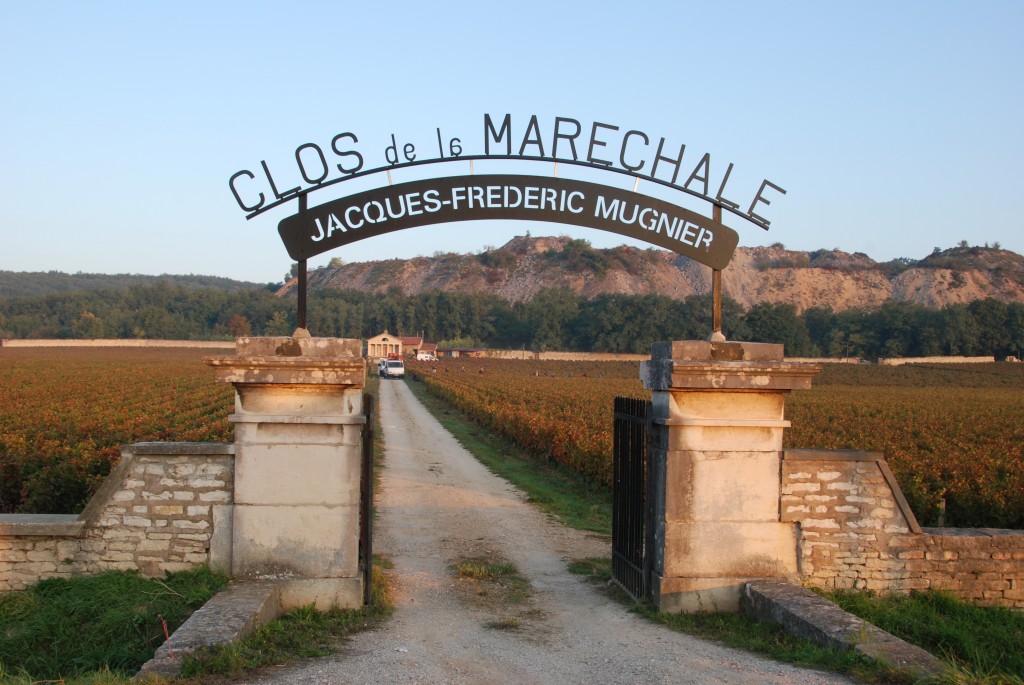
“What I realise with the Clos, it that it’s easier to maintain the quality in a large vineyard than a small one.”
“Dr Lavalle (in this book Histoire et Statistique de la Vigne de Grands Vins de la Côte-d’Or) describes it as a delicate and stylish wine from Nuits Saint George. This section of Nuits-Saint-Georges makes more delicate wines than typical Nuits Saint George.”
“People ask me which are my favourite vintages. But what I like best is often not the best vintage, but when I get really good results and unexpected results.
“What surprises me is the evolution of the 2012. The palate of flavours are similar with the 2011 and 2012. It is more drinkable than the 2012s. this. These wines are made to age, but some can be drunk earlier. The 2011 can be drunk a little earlier. But with any of these vintages if you open them before, you do not get the full picture. The full expression. When you drink them young, you only get the most primary flavours. It is important to preserve the tradition of ageing wines.”
“I feel that ten years is necessary to develop some complexity in any vintage. For me the 2013 is a vintage which will especially benefit from ageing.”
“What is interesting in wine is not what it is, but what it does to you. “
“I like more and more the cold and rainy vintages. It is more work for us, but in the wine…It is not the vines that have to suffer to make good wine, but the wine grower!”
“The best grapes are when the vines grow in a comfortable environment, which is not comfortable for us. No excellent of heat and cold and some rain and temperate weather. It may be better to have too much rain than not enough.”
Nuits-Saint-Georges, Clos de la Maréchale 2004 to 2015
Tasted in 2016 and published originally in the Burgundy Briefing 2015 Vintage Report. My tasting notes are followed by Frédéric’s comments.
*Nuits-Saint-Georges, Clos de la Maréchale 2015
Ripe mulberries and white pepper aroma. Ripe fruit on the attack. This is juicy and quite dense and the tannins are firm, plentiful and juicy…there are aromas on the finish. It is lively too. The energy is there and a delicious succulence. Score 18.65-75
Nuits-Saint-Georges, Clos de la Maréchale 2014
Red fruits and plenty of them. Juicy jump onto the palate. This is really rather exuberant. Delish. it is fresh and tasting very well indeed. Soft, smooth tannins. Bite on the finish. Just yummy now. Of course it will age, but it is at a moment of lovely accessibility. Score 18.5
Nuits-Saint-Georges, Clos de la Maréchale 2013
Elegant aroma of red fruits. Appealing fresh, red fruits and cool acidity in the middle. You sense the coolness. The tannins are firm, while not the finest, they nicely supportive, rather supple and flow well in the palate with the fruit. It is zesty, cool acidity and energetic on the finish. Vivacious. From 2023 18.10
“It is not the most elegant of the vintages. There is some rusticity in the vintage. I was not expecting the quality of this vintage and the texture of the tannins and this wraps the acidity. You do not see the acidity. It should develop and age very well.”
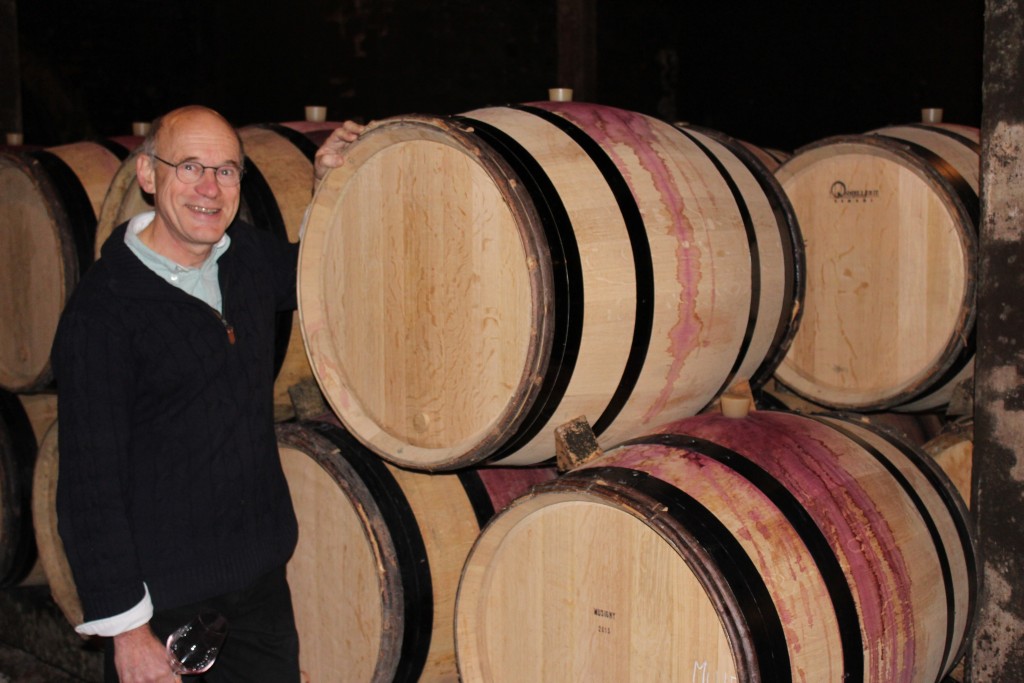
**Nuits-Saint-Georges, clos de la Maréchale 2012
Rich aroma of deep red and black fruits. This smells much riper on the nose and has morello cherry fruits on the palate. Excellent depth and thicker, ripe tannins. It is quite opulent in the texture, but dense, deep and very compact. Lovely rich fruit with a fresh succulence on the finish.. with the freshness inside the fruit. There is a generosity. It has power on the finish. Score 18.55
“It is quite tight at the moment. I did not think this would close down. This was the wine I advised my customers would stay open.”
Nuits-Saint-Georges, Clos de la Maréchale 2011
Notes of ripe cranberry on the nose. Supple and silky onto the palate. Glides easily and gently. It is sweet, silky and rippling and has a refreshing lift at the end. Very nicely balanced and very harmonious. It is soft, but that at the end brings it together. Score 18.
***Nuits-Saint-Georges, Clos de la Maréchale 2010
Bright, ripe and expressive fruit on the nose. It has a gorgeous satin texture and ripples very elegantly and freshly. The sweet fruit encases the fresh acidity. The tannins a svelte. It has great intensity and persistence on the finish..and it show a salty character at the end of the palate. For me this has the perfect balance. Brilliant. Score 18.75
“It is so fresh and so exciting,” remarks Frédéric.
It seems that Frédéric would actually like to drink this now – as well as later and comments “the good thing in the Clos La Maréchale is is that the bottles are not rare. They are readily available. You could drink a bottle like this today and then drink another bottle with age.”
Nuits-Saint-Georges, Clos de la Maréchale 2009
Rich, dense and full. A ripe wine. It shows the warm summer. It is quite extravagant. The tannins at the moment are from and grippy. This needs time to smooth and resolve. After the large palate it has enough freshness at the end, but this is not a vintage through which it is easy to see the terroir. The vintage speaks first. I think it has great ageing potential – 20 years plus, but it is not my favourite in the flight for all its heady power.. Score 18.50. To put away for a long time..
“It is very resistant to oxidation so it will keep for ever and you should leave it. Age will bring a complexity. It is powerful and rich and ripe. Yes the problem is that 2009 is not a wine for the collectors. The character of the vineyard is not expressed clearly. Not necessarily the most Burgundian, Burgundy. It seems this year that Burgundy just slipped to the south,” muses Frédéric.
*Nuits-Saint-Georges, Clos de la Maréchale 2008
This is has a cool aroma showing just a hint of evolution with the fruit. There are some late summer hedgerow notes. A surprisingly fluid and very elegant palate. The tannins are silly. The wine is fresh and energetic. A lively long and fresh finish. This has a tension and minerality at the end. Transparency to the terroir. A delightful 2008. Score 18.4.
“It does not have a rich body, but it is all spirit. It is inspiring wine. I have change my image of it now. It has put on a little weight and shows some darker flavours and it is more NSG than we thought. I always found in it the image of ‘light’ ..a luminosity..full of light. This vintage is a Cistercian wine. There is something minimalist here. It is the essence of the wine. Just the spirit, says Frédéric.
Nuits-Saint-Georges, Clos de la Maréchale 2007
This has alluring aromatics. Soft and elegant and juicy. It is easy onto the palate. A little plump in the middle. And then the tannins come in and are more robust than expected. I prefer the tannins and silky texture of the 2008. This is not as fine in texture. But none-the-less it has a somewhat gusty charm and an aromatic sweetness at the end. Score 17.9
“The tannins are more rustic. I like this though I am a farmer. This is my world,” says Frédéric. “The 2007 is more physical..the 2008 more cerebral.”
Nuits-Saint-Georges, Clos de la Maréchale 2006
Showing some evolution, notes of dark chocolate, forest floor..becoming interesting. Still quite tight on the strike though. Full-bodied, chunky and broad. It’s a bigger boned wine; robustly structured. It not elegant. The tannins are quite burly, but I do like the fact it is fresh and has a bite..mineral bite at the end..some what bitter. It would be great with a meal. Score 17.65
Frédéric comments “In a fully mature you expect the edges to be integrated, but not in a ‘relatively young wine and this is still too young.”.
He recalls, “I was worried to begin with the tannins as they were so strong and dry and green and then the wine become fruity and friendly a the end of the ageing in barrel. And now after a few years in bottle they have come back. I like it when a wine is not perfectly polished. This is still a young wine. It has character and I anticipate the sharpness will resolve with more age. The flavours are interesting… no longer primary fruit.”
“Yes it would be good with food now. With food you need something bitter, or acidity or tannins if the wine is too sweet it is not so good with a meal.”
*Nuits-Saint-Georges, Clos de la Maréchale 2005
This is also showing a touch of evolution the nose, not a much as 2006, but dark fruits couple with more secondary characters. What strikes you is the sublime texture, satin soft now, rich, but fine. It has a wonderful depth, intensity and sophistication. It glides. Such energy and complexity. This has tension and coiled vigour. the energy is still unfurled. It has that splendid thing…a vibration on the finish.. Score 18.9. I would wait another few years – maybe five or so for it to develop more nuances, but it will continue to age for a very long time.
“It is very aristocratic. Very well behaved. Everything is integrated. Everything is in place and it will evolve now for a long time…it will become great. It is not exuberant. This needs much more time to fully appreciate it,” says Frédéric.
Nuits-Saint-Georges, Clos de la Maréchale 2004
This while this has the mark of the vintage in the aroma and flavour..a green note, the tannin are integrating. As it opens the texture reveals itself and it softer and smoother. It is fresh. It has energy. There is a flavour of the vintage, but it does have an elegance. I like the cold finish. Score 17.4
“I love this wine. I am very proud of this wine. It is easy to make a great wine in those few great years. It is much more difficult to make good wines every year,” says Frédéric.
“It was a very challenging vintage in the vineyard. Everything was new. I had a new team and a new fermenting room. It was rainy and the vigour of the wines was high. We had so much work in 2004 and we managed to get good looking grapes, ripe and healthy and so I was proud of my grapes. I love this wine. Ok there is some greenness there, but the texture is good and the wine is not thin. It is round and deep enough and has some good fruit and some greenness, which I understand some people do not like I sell this wine to a restaurant in Paris who loves it. the chef cooks only vegetable and this is a good wine to match with this sot of food. With some vegetable dishes which will not match with anything else, this wine is the answer.


